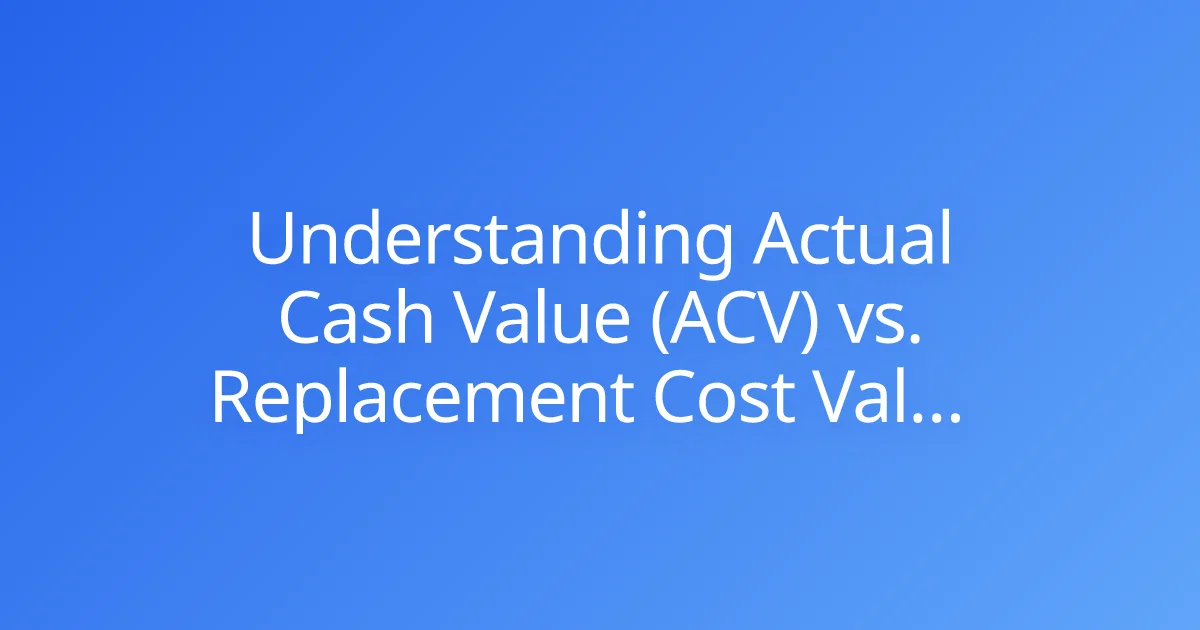What is Subrogation in Insurance and How Does It Affect You?
Have you ever heard the term "subrogation" mentioned in the context of an insurance claim and wondered what it means? For many policyholders, it sounds like complex legal jargon, yet subrogation in insurance is a common, often behind-the-scenes, process that can directly impact your financial recovery after a loss. Understanding this principle is crucial, especially when an accident or damage is caused by someone else's negligence. Without this knowledge, you might miss out on reimbursement or misunderstand your insurer's actions.
At The Policy Explainer, we're dedicated to clarifying these intricate insurance concepts. This comprehensive guide will demystify what is subrogation in insurance by explaining its core definition, how it works in real-world scenarios, and most importantly, how it directly affects you, the policyholder. By the end, you'll feel empowered with a clearer understanding of this vital part of the claims process and how it protects both your insurer and your financial interests.
Understanding the Core Concept of Subrogation
At its simplest, subrogation is the legal right of an insurance company to seek reimbursement from a third party who is responsible for a loss paid by the insurer. It essentially allows the insurance company to "step into your shoes" to recover the money they paid out on your behalf from the at-fault party.
Definition and Purpose
- Definition: Subrogation is the process by which an insurance company, after paying a policyholder's claim, pursues the party legally responsible for causing the loss to recover the amount paid.
- Purpose:
- Prevents Double Recovery: It ensures that you, the policyholder, do not "double-dip" by receiving compensation from both your insurer and the at-fault party for the same loss.
- Transfers Responsibility: It shifts the financial burden of the loss from your insurer (and indirectly, from all policyholders through premiums) to the party who was actually at fault.
- Maintains Premium Stability: By recovering losses, insurers can help keep overall premiums lower for everyone, as they are not solely absorbing the costs of damages caused by negligent third parties.
- Promotes Fairness: It upholds the principle that the party who causes the damage should ultimately bear the financial responsibility.
The Parties Involved
To understand subrogation, it's helpful to identify the three main parties:
- The Insured (You): The policyholder who suffers a loss and files a claim with their own insurance company.
- The Insurer: Your insurance company, who pays your claim according to your policy terms.
- The Third Party (At-Fault Party): The individual or entity legally responsible for causing your loss or damage.
How Subrogation Works: A Step-by-Step Scenario
Let's walk through a common example to illustrate the subrogation process.
Scenario: A Car Accident
Imagine you are driving, and another driver runs a red light and collides with your car, causing $5,000 in damages.
Step 1: Your Insurer Pays Your Claim.
- You file a claim with your own auto insurance company for the damage to your car under your collision coverage.
- You pay your deductible (e.g., $500).
- Your insurer pays you (or the repair shop) $4,500 for the repairs ($5,000 damage - $500 deductible).
Step 2: Your Insurer Initiates Subrogation.
- Since the other driver was at fault, your insurance company has the right to recover the $4,500 they paid out.
- Your insurer (or their subrogation department/vendor) contacts the at-fault driver's insurance company. They present evidence (police report, photos, repair estimates) to prove their insured's liability and demand reimbursement for the $4,500 they paid.
Step 3: Recovery (or Lack Thereof).
- Successful Recovery: If the at-fault driver's insurer accepts liability, they will reimburse your insurer the $4,500.
- Unsuccessful Recovery: If the at-fault driver is uninsured, underinsured, or their insurer disputes liability, your insurer may not be able to recover the full amount.
Step 4: Deductible Reimbursement.
- If your insurer successfully recovers the money from the at-fault party's insurer, they are typically obligated to reimburse you for your $500 deductible that you initially paid. This is a crucial benefit for policyholders.
Subrogation Across Different Insurance Types
The principle of subrogation applies to various types of insurance, not just auto.
Auto Insurance
- Most Common Application: As shown in the example, auto insurance is where subrogation is most frequently seen. If someone else causes an accident, your insurer will pursue their insurance company to recover damages paid under your collision or uninsured motorist property damage coverage.
- Deductible Recovery: This is often how policyholders get their deductible back when they're not at fault.
Homeowners Insurance
- Property Damage Caused by Third Party: If a neighbor's tree falls on your house, or a contractor damages your property during a renovation, your homeowners insurer will pay your claim and then subrogate against the neighbor's liability insurance or the contractor's bond/liability insurance.
- Product Liability: If a defective product (e.g., a faulty appliance) causes a fire or water damage in your home, your insurer may subrogate against the manufacturer.
Health Insurance
- Accidents Caused by Third Parties: If you are injured in an accident (e.g., a car accident, a slip and fall) caused by someone else, your health insurer may pay your medical bills. They then have a right of subrogation to recover those costs from the at-fault party's liability insurance (e.g., their auto bodily injury liability or homeowners liability).
- "Third-Party Liability" or "Coordination of Benefits": Health insurance policies often have clauses related to subrogation, sometimes called "third-party liability" or "coordination of benefits," ensuring they are not paying for medical expenses that another party or insurer is legally responsible for.
Workers' Compensation Insurance
- If an employee is injured at work due to a third party's negligence (e.g., a delivery driver from another company causes an accident on site), the workers' comp insurer will pay the employee's medical bills and lost wages, then subrogate against the negligent third party.
How Subrogation Affects You, The Policyholder
While often invisible, subrogation has direct and significant impacts on you.
1. Reimbursement of Your Deductible
This is the most tangible benefit. If your insurer successfully recovers money from the at-fault party, you will typically get your deductible back. This can be a huge relief, especially after a significant loss.
2. Protecting Your Future Premiums
When your insurer recovers a payout from an at-fault third party, it can help prevent your own premiums from increasing due to that specific claim. If your insurer has a strong subrogation recovery rate, it can contribute to more stable rates for all policyholders.
3. Avoiding Direct Legal Action (Generally)
Subrogation means your insurer handles the messy process of pursuing the at-fault party. You don't have to hire a lawyer or directly engage in legal battles to get compensated for your damages. Your insurer manages the recovery effort on your behalf.
4. Your Obligation to Cooperate
You have a duty to cooperate with your insurer's subrogation efforts. This might include:
- Providing all documentation related to the loss.
- Signing a "subrogation agreement" or "trust agreement" (which authorizes your insurer to pursue recovery on your behalf).
- Not settling with the at-fault party directly without your insurer's knowledge, as this could jeopardize your insurer's subrogation rights and your coverage.
Important Considerations and Tips
- Don't Settle Directly: Never accept a settlement or sign a release from a third party or their insurer without first consulting your own insurance company. Doing so could waive your insurer's subrogation rights and potentially leave you responsible for your deductible or even the full damage.
- Cooperate Fully: Provide all requested information to your insurer promptly. Your cooperation is essential for their successful recovery efforts.
- Keep Records: Maintain detailed records of the incident, communications with all parties, and all expenses related to the loss. This documentation supports both your initial claim and your insurer's subrogation efforts.
- Understand Your Deductible: Be aware that getting your deductible back is contingent on your insurer's successful subrogation. If the at-fault party is uninsured, underinsured, or liability cannot be proven, you may not recover your deductible.
- Subrogation Can Take Time: The recovery process can sometimes be lengthy, especially if liability is disputed or legal action is required. Patience is key.
Conclusion
Subrogation in insurance is a powerful principle that ensures fairness and protects the financial interests of both policyholders and insurers. By allowing your insurance company to "step into your shoes" and pursue reimbursement from an at-fault third party, it simplifies your recovery, often leading to the reimbursement of your deductible, and helps keep overall insurance costs stable.
While it often happens behind the scenes, understanding this key concept empowers you to cooperate effectively with your insurer and ensures you receive the full benefit of your coverage. Don't let the legal-sounding name intimidate you; subrogation is ultimately designed to work in your favor when another party is responsible for your loss. Do you have more questions about how subrogation might apply to a specific type of claim, or are you wondering about the timeline for deductible reimbursement?



